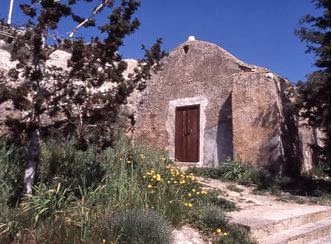The doors of the renovated chapel of Agios Antonios were opened this morning, on the day of his feast, in the homonymous forest in Sotira. The inauguration was performed in a solemn doxology by the Most Venerable Metropolitan of Constantia and Famagusta, Mr. Vassilios.
The chapels of Agios Antonios:
The Byzantine church of Agios Antonios is located on the hills southeast of the village in a deserted location with bush vegetation, on the border of Paralimni and Sotira. This rocky area was a popular haven for shepherds who used to spend the night there with their flocks. It is a small one-room vaulted church. It is a Byzantine church built in the 16th century. Traces of murals are preserved on the surfaces of the walls. Next to the old chapel was built in 1986 a larger church in the type of a simple one-room vaulted roof. This church was built with the efforts of Fr. Antonios Ioannou and Fr. Vassilios Nikolaos, then a student at the Theological Seminary. The old chapel was restored with the contribution of the City Hall of the Savior in 2013. The openings took place on January 17, 2014.
Saint Anthony:
Antonios the Great was born in Egypt in 251 AD. His special homeland was a small village called Koma, located east of the Nile River, in southern Memphis.
He came from wealthy and pious Christian parents. They had the opportunity to offer him a great education and to make him a great scientist, but they were afraid of socializing at school with the children of the pagans. He did not want to lose his faith because of the delusion of idolatry. His parents took great care of his Christian upbringing. They preferred to see their child in Paradise illiterate, rather than literate in Hell. But that did not stop him from becoming Great. It was based on the Gospel. Although still young, he turned to God and paid no attention to the details of earthly life.
At the age of 18 or 20, he became an orphan. He lived with his sister. With the death of his parents he realized how short this life is.
Shortly after the death of his parents, hearing the Gospel passage in the Church, where Christ called the rich young man to donate his possessions to the poor, moved by it, he followed the Lord's command, giving his own property to the poor.
He then built a cell in a deserted and remote place and thus began his ascetic life, having as an example an Elder whom he had met and admired for his virtue. He worked non-stop, and followed a life full of fasting and exercise. Later he went near the ruins of a fortress and then lived in a cave. He had managed to transcend the limits of human nature, making terrible struggles, always with the help of God.
After twenty years of training, he decided to appear in the world. He was greeted with admiration. It is said that while the Saint was alive, he saw the souls of the dead as they came out of the body and were led by demons. This gift is a feature of angels. He often slept alone on a mat or on the ground.
In 311 AD, the emperor Maximian began a persecution against the Christians and so Antonios the Great went to Alexandria to help the faithful, the Confessors and the Witnesses. When the persecution ceased, he wanted to return to his ascetic life. Then he left there, because he could not in the crowds and so he went to a desert place, on a high mountain, near the Red Sea. And there many followed him to receive his blessing and to be healed.
In his old age, now, in 338 AD, while Orthodoxy is in turmoil due to the Arian sect, he asks for his help. The Martians disturb the peace of the Church and try to falsify the faith. So at the age of 100, he goes to Alexandria, in order to guard the true faith from the sect of Areios and to fight his misconceptions. Antonios the Great had correspondence with Constantine and his sons, who sought the advice of the Saint.
Antonios the Great, after living one hundred and five years, slept in 356 AD. He accurately predicted his death and his memory is celebrated on January 17.

